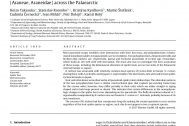Year
2017Authors
Ivan MihálRNDr. Petr Dolejš, Ph.D.
Stanislav Korenko
Species
Cyclosa conica (Pallas, 1772) ESContent
Most parasitoid wasps establish close interactions with their host taxa, and polysphinctines (ichneumonid koinobiont spider-ectoparasitoids) are no exception. Two polysphinctines, Zatypota picticollis and Reclinervellus nielseni, are, respectively, partial and exclusive parasitoids of Cyclosa spp. (Araneidae), which build an orb web with web decoration. The main aim was to investigate the host association of these wasps, including the behavioural alteration of spider hosts across two sides of the Palaearctic (Central Europe vs. Japan).
R. nielseni was associated with relatively common local species of Cyclosa both in Europe (Cyclosa conica), sharing these with Z. picticollis, and in Japan (C. argenteoalba). We also found a new alternative host spider, Cyclosa laticauda, in Japan.
Host web alterations were observed in all parasitoid-spider interrelationships. The alteration patterns of the two polysphinctines have a similar constructional plan that exploits pre-existing frame lines for the cocoon webs
however, they differ partially in their radii, which are either straight or zigzag shaped and in hub loops present or absent. This indicates that certain differences in the neurophysiologic changes in the spider host occur depending on the parasitoids. The fluffy decoration induced in C. argenteoalba manipulated by R. nielseni was not found in Cyclosa conica or C. laticauda, probably because of its non-innateness.
The cocoons of R. nielseni had four conspicuous long ribs making the cocoon quadrate in cross-section regardless of the host spider species or region
such ribs do not appear in two co-generic species.



